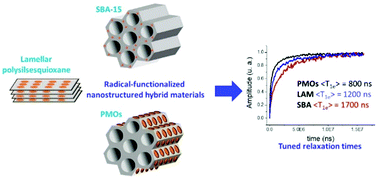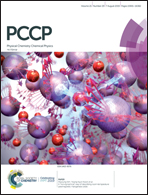Modulating lifetimes and relaxation times of phenoxyl radicals through their incorporation into different hybrid nanostructures†
Abstract
The development of new open shell systems is essential for advances in spin science. In this work, we report the synthesis and characterization of three nanostructured materials, namely SBA-15 silicas, periodic mesoporous organosilicas (PMOs) and lamellar polysilsesquioxanes, all functionalized with the same diazene-based phenoxyl radical precursor. The impact of the nature of the material, i.e. loading of radical precursor and structure, on half-lifetimes (t1/2) and relaxation times of phenoxyl radicals was investigated. Although phenoxyl radicals are transient in solution, their t1/2 range from hours to years at room temperature (RT) when they are embedded in nanostructured materials. The above mentioned functionalized materials were used to generate the corresponding phenoxyl radicals and their relaxation times were measured (〈T1e〉 and Tm) from 50 K to RT. The results were rationalized in terms of limited mobility of the radical as a result of supramolecular interactions and structure rigidity. All these data show that it is possible to design functionalized nanostructured material with radicals possessing specific electronic relaxation properties which can be of interest in fields like DNP, organic magnetism or spin qubit.



 Please wait while we load your content...
Please wait while we load your content...